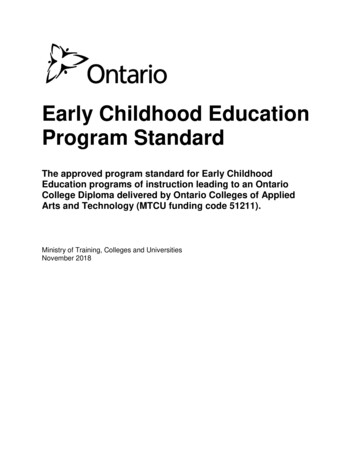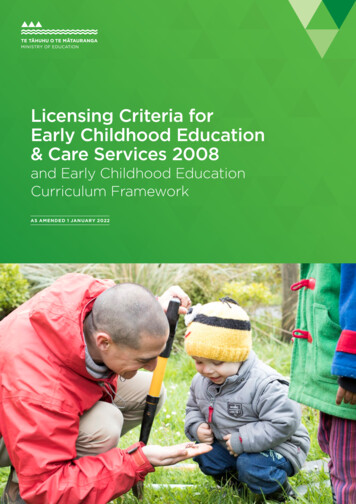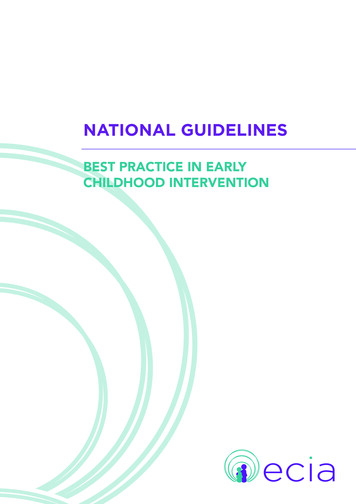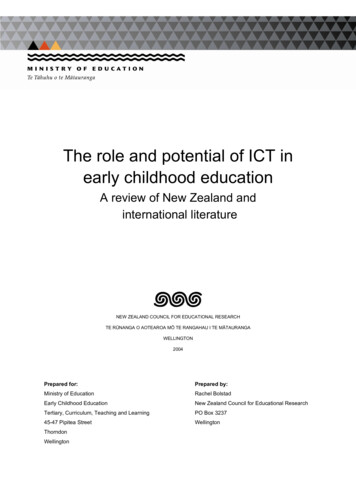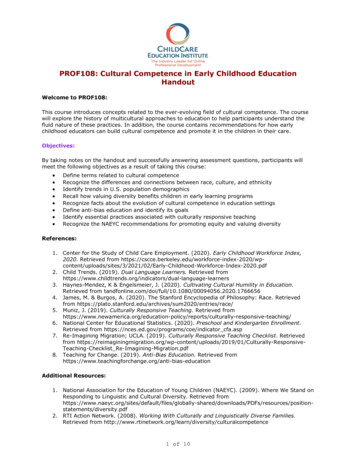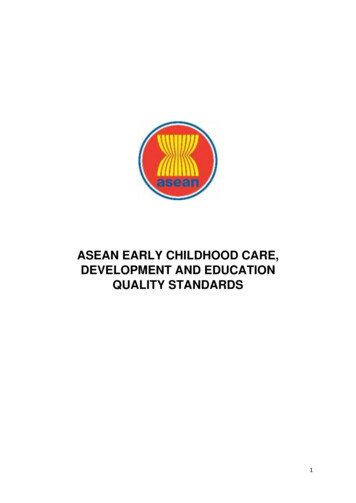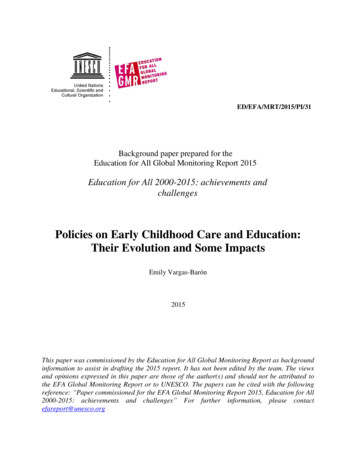
Transcription
ED/EFA/MRT/2015/PI/31Background paper prepared for theEducation for All Global Monitoring Report 2015Education for All 2000-2015: achievements andchallengesPolicies on Early Childhood Care and Education:Their Evolution and Some ImpactsEmily Vargas-Barón2015This paper was commissioned by the Education for All Global Monitoring Report as backgroundinformation to assist in drafting the 2015 report. It has not been edited by the team. The viewsand opinions expressed in this paper are those of the author(s) and should not be attributed tothe EFA Global Monitoring Report or to UNESCO. The papers can be cited with the followingreference: “Paper commissioned for the EFA Global Monitoring Report 2015, Education for All2000-2015: achievements and challenges” For further information, please contactefareport@unesco.org
Policies on Early Childhood Care and Education:Their Evolution and Some ImpactsEmily Vargas-BarónThe RISE InstituteJuly 2014AbstractThis study presents some of the major drivers and challenges encountered in policyplanning for early childhood care and education (ECCE), an analysis of the evolution ofECCE policy planning in all world regions from before 2000 to the present, and dataregarding the current national and regional distribution of ECCE policies, strategic plansand laws.1 As of July 2014, at least 68 countries had adopted one or more of these ECCEpolicy instruments. An additional 10 countries are reliably reported to have adoptedpolicy instruments, and 23 countries are currently preparing them. Country case studieson policy development and initial implementation are provided, including Bosnia andHerzegovina, Brazil, Colombia, Myanmar and Rwanda.2 Finally, salient conclusions andrecommendations are offered.1.IntroductionThis study reviews the evolution of policy planning for early childhood care andeducation (ECCE) in all world regions and discusses salient impacts resulting fromconducting policy planning processes and implementing policy instruments. The policyinstruments studied include national ECCE policies, strategic plans and laws.National ECCE policies are multisectoral and they usually include the followingsectors: education, health, nutrition, sanitation, and protection. They provide a generalframework for operational planning, including the vision, mission, goal, core concepts,objectives and strategies for ECCE. A few ECCE policies are, in actuality, brief ‘policystatements’ that present the general intention of the country to focus investments on allaspects of young child development. Policy statements rarely provide sufficient guidancefor expanding and improving comprehensive ECCE services and activities.National ECCE strategic plans (often simply called national ECCE strategies)usually are operational plans, which are developed to guide the implementation of an1The term ECCE is used in this study due to UNESCO’s decision to employ this term in English. ECCE is understoodto stand for ECD, ECCD, ECEC, ECED, IECD, IECCD and other terms that nations use to refer to multisectoral and/orintegrated approaches to early childhood systems and services. Of these English terms for ECCE, the ones mostfrequently used throughout the world are ECD and ECCD.2I wish to express my deep gratitude to the following national specialists who responded to a survey questionnaire thatI sent them: Ms. Selena Bajractarevic (Bosnia and Herzegovina), Dr. Vital Didonet (Brazil), Ms. Carolina Cuevas(Colombia), Mr. Janvier Gasana and Ms. Venerande Kabarere (Rwanda), and Dr. Thein Lwin and Dr. Aye Aye Yee(Myanmar). In addition, Mr. Javier Saenz Core, Consultant (Argentina) was very helpful. These leaders are some of theunsung heroes of successful national ECCE movements. May their dedication inspire others to follow their lead!1
ECCE policy. As will be shown in this study, several countries have prepared both ECCEpolicies and strategic plans. However, some national ECCE strategic plans have beendeveloped without the guidance of an ECCE policy. When this occurs, strategic planstend to assume many of the attributes of a national ECCE policy. ECCE strategic plansusually include a detailed action plan that specifies the activities and services that are tobe developed under each strategic priority, including the tasks, steps or phases ofactivities and service implementation, responsible agencies involved, indicators andtargets, and annual budgets per task.National ECCE laws tend to focus on general guiding principles and regulations.Usually they are briefer than ECCE policies and strategic plans. As will be seen in thisstudy, relatively few multisectoral ECCE laws exist. This may be due to the need toensure multisectoral coordination within the executive branch of government; activitiesthat are often best led and managed by the executive branch.Bylaws, regulations, decrees, and standards for services, personnel and theirperformance have not been included in this review. Usually they are developed as a resultof the adoption of ECCE policies, strategic plans or laws. It is fully recognised that theyoften play important roles in implementing policies.Every effort has been made to identify and obtain copies of all of the multisectoralECCE policy instruments that have been developed to date.3 For this study, no attemptwas made to collect and analyse the many sectoral policies, plans and laws that exist inthe five main ECCE sectors. This is due to their often transitory nature and because theyrarely provide guidance for multisectoral coordination and cross-sectoral serviceintegration unless a multisectoral ECCE policy already exists. There are exceptions tothis, such as the early and preschool education strategies of Montenegro and Georgia, butthey are few in number.This study offers observations on the following topics: Main challenges facing governments as they develop and implement ECCEpolicies;A brief historical review of ECCE policy planning activities in several countriesand the main world regions;Results from a desk study of policy instruments on early childhood care andeducation (ECCE) collected by the author;Results from a brief survey conducted in five countries of four regions: Bosniaand Herzegovina (CEE/CIS); Brazil and Colombia (Latin America); Myanmar(Southeast Asia); and Rwanda (Sub-Saharan Africa);4 and3Readers are encouraged to send copies of national ECCE/ECD policy instruments that have been officially adopted tothe author: vargasbaron@hotmail.com4The author is currently conducting an in-depth study of these and other aspects of early childhood policy planningprocesses, instruments and their implementation and impacts in many nations.2
Major conclusions derived from these five case studies and a fewrecommendations regarding the expansion and improvement of ECCE policyplanning and implementation.Many national multisectoral ECCE policies have been developed in spite of variousdaunting challenges in regions and nations. The following section discusses some of themajor challenges and barriers that have been encountered.2.Main challenges facing governments that develop and implement ECCEpoliciesAbundant experience and various studies have revealed that governments face manychallenges and barriers in developing and implementing multisectoral ECCE policyinstruments that seek to ensure universal access to comprehensive early childhood careand education services, and especially those that target poor and marginalised families.The following discussion presents selected policy challenges as well asobservations regarding some of the ways that they have been overcome. Salientchallenges have been disaggregated into external and internal contexts.a.External challengesDictatorships and other authoritarian regimesOne of the most difficult challenges is conducting ECCE policy-planning processes incountries with dictatorships and other types of authoritarian regimes. Sometimescountries led by an authoritarian regime may seem easy to work in because a “leader”declares that everyone will support ECCE policy planning, and consequently relevantministries appear to become actively engaged in policy planning processes. However,later they may not follow through on their promises. Sometimes such leaders mainlyaddress children’s issues in order to meet the requirements of international conventions,and subsequently they may not follow through with policy adoption and/orimplementation. The political will on the part of some ministers who personally profitfrom the regime may turn out to be quite low. It is important for ECCE policy planners tobe aware of such potential challenges from the outset.Options: A high proportion of nations have authoritarian regimes. Some policyadvisors refuse to work in these countries. However, if we were to wait for to them tobecome more democratic, generations of children would not benefit from the ECCEservices that they require. Therefore, it is essential to make every effort to take advantageof an authoritarian leader’s openness to ECCD policy planning and help ministries andcivil society organisations in their efforts on behalf of young children. In such countries,it is very important to conduct a participatory planning process, so that many people inthe country at central, regional and municipal levels will become seized with thepotential of expanding and improving ECCE services. If this occurs, we find that ECCE3
leaders will begin to implement many aspects of an ECCE policy even without officialpolicy adoption and strong central support for implementation. Abundant experience hasdemonstrated that non-participatory approaches to policy planning tend to result inpolicy documents that are never implemented (Crouch, L. and Healey, F. H. (1997).However, should an authoritarian leader and a nation’s key ministers expressabsolutely no interest in developing an ECCE policy instrument, there is little point ininsisting on developing a policy in the face of overwhelmingly negative odds. Support forindividual ECCE situation analyses, programmes, and training systems might beconsidered instead.Lack of “political will”Interestingly, a lack of “political will” at the highest levels is often more challenging thanworking with authoritarian regimes. Sometimes a lack of political will may be linked toperceived political interests, certain cultural, national or personal values, or simply to alack of opportunities to learn about ECCE systems of services and their many short-,medium- and long-term benefits.A lack of political will is not always clearly evidenced. A minister or deputyminister may mouth words of support; however, behind the scenes s/he may quietlytorpedo participation in the ECCE policy planning process. In addition to a lack ofpolitical will at the central level, a similar lack of interest at regional and/or municipallevels can occur, and can substantially derail policy implementation.Options: Policy advocacy should begin upon the initiation of the policy planningprocess. The points of resistance and support should be clearly identified early on in thepolicy planning process. Policy advocacy should include presentations on the benefitsand rates of return on investment of ECCE, the key service gaps and needs of the country,and the ways that increased investment in ECCE could benefit each sector and thecountry as a whole in the short-, medium-, and long-term.Policy leaders and key decision makers should be invited to engage in smallgroup and private discussions (interviews) that permit them to air their doubts andconcerns and share their ideas. Once decision makers realise that short- and mediumterm benefits will accrue to them as political or policy leaders, they often become strongsupporters of ECCE or at least they no longer stand in the way of policy development andimplementation. In many instances these naysayers have subsequently given talks to theirconstituencies to present their ideas regarding the importance of ECCE services. Byinvolving regional and municipal leaders in the ECCE policy planning process, theyusually become strong supporters of an ECCE policy that includes some of therecommendations they gave during the development of the policy instrument.Rapid turnover in government administrations resulting in little follow through4
Rapid turnover in political leadership, including parliamentarians, ministers, deputyministers, permanent or principal secretaries, and department heads, can be exceedinglydetrimental to ECCE policy planning and implementation. This has occurred in variouscountries during and immediately after policy planning processes were conducted, and ithas always been disruptive. On the average, one to two years may be lost in movingECCE planning activities forward while new decision makers learn how to do their jobsand come to understand the benefits of investing in ECCE – a policy espoused by theirpredecessors. In a few countries, little could be done to resurrect or update draft ECCEpolicies.Options: Policy planners should try to anticipate such situations by ensuring allpolitical parties and leaders from different groups are included in ECCE policy planningto the extent possible. At a minimum, the “opposition” should be informed that, shouldthey gain governmental control, the policy planning process that is underway or recentlyconcluded could benefit them as a “quick win” for their new administration – a termused increasingly in a wide variety of countries. In nations with recourse to democraticgovernance and the rule of law, the policies of prior administrations tend to be upheld.Over time, policy instruments are usually amended or replaced. This is oftenbeneficial since national contexts evolve and new plans are needed. However, it issignificantly harder to ensure policies will be maintained in countries with authoritarianregimes. For example, in a country with revolving dictatorships, it is very challenging toensure that a new dictator and his followers will honour prior policy commitments. In afew countries, it has proven to be impossible to continue policy implementation.Decentralisation without technical guidance for ECCE given to regional, district andmunicipal levelsThe rapid decentralisation of ECCE services and budgets that had been centrally plannedand managed to regional, district and/or municipal levels, often results in a noncompliance with ECCE policies and plans. This especially occurs in those countrieswhere clear roles and responsibilities have not been delegated to each level, beginningwith the central level. Regional and local levels often lack essential training, guidelinesand well-designed systems for local management, equity, quality and accountability.The results of rapid decentralisation have been catastrophic for ECCE services inseveral countries. Well-functioning ECCE programmes for vulnerable children have beenterminated, systems for quality assurance and accountability have ended, and supervisorysystems have disappeared -- if it there had been a supervisory system in the first place. Insuch situations, ECCE funds have been diverted to other uses, such as building municipalfacilities, constructing roads – anything but services for young children.Options: ECCE policy planners should seek to learn about each nation’s plansfor decentralisation and meet with relevant national planners. They should anticipate theusual challenges before they occur and work with national planners to ensure a full planfor decentralisation is included in the ECCE policy, strategic plan or law. These policy5
instruments can provide for the development of training packages for regional leaders,mayors and community councils, accompanied by guidelines for their roles andresponsibilities, supervisory systems, and regulations for management, equity, qualityassurance, and accountability. These activities should be called for in ECCE policyinstruments, and to the extent possible, prepared and implemented before funds aredecentralised. In several instances where decentralisation has already occurred andECCE services have suffered from mismanagement or worse, ECCE policy instrumentsshould address each issue related to building a strong national ECCE system of servicesat all levels.Extreme sectoralityA sectoral approach to ECCE is always found in all countries. Nations will continue towork in a sector-by-sector manner if multisectoral ECCE policies, strategic plans and/orlaws are not developed. By definition, ECCE policy instruments are multisectoral. Theyalways include sectoral services plus multisectoral coordination and services. Somepolicy instruments also feature integrated services at local levels wherever they can bedeveloped.Because multisectoral planning and coordination can be more challenging thansectoral planning, some observers have asserted that sectorality precludes thedevelopment and implementation of multisectoral ECCE policy instruments. However, inmost nations this has not been the case. In countries of some regions, such as severalnations of the Caribbean and Eastern Europe, extreme sectorality has been found. Inmany cases this tendency has been overcome through using participatory policy planningmethods.Options: In countries with extreme sectorality that lack a tradition ofmultisectoral coordination or even collaboration, new incentives have been establishedthat reward sectoral leaders for their participation in multisectoral policy planning. Forthis to occur, it can be helpful to have the President, Prime Minister or even a First Ladysupport the formation and work of a multisectoral ECCE committee or council. Oncethey are formed, policy advocacy and the use of a highly participatory policy planningapproach will usually overcome extreme sectorality. When leaders experience therewards that result from multisectoral coordination and from integrating some servicesat regional or local levels, they often become willing to establish interagency agreementsthat will enable the development of multisectoral coordination and sustainablemultisectoral ECCE service systems.b.Internal challengesKey internal challengesExtensive research has revealed that at least eight key elements are required to establish acomprehensive, strong and sustainable national system of ECCE services. They include:6
1. Equity and child and parental rights;2. Multisectoral coordination and local service integration, where possible;3. A governance system that includes essential structures for policy developmentand implementation, such as a national ECCE council, an ECCE policyimplementation institute or unit, and regional and municipal ECCE committees;4. Standards and regulations for services, personnel and personnel performance;5. Quality improvement and resource development, including improved curriculaand methods, pre- and in-service training, certification and recertification systems,etc.;6. Systems of accountability, including supervisory systems, monitoring, evaluationand reporting linked to annual planning systems;7. Adequate investment in systems that will take key programmes to scale on aphased basis; and8. Policy advocacy and social communications to promote policy implementation(Vargas-Barón, 2013).These eight elements should be addressed effectively within ECCE policy instruments inorder to help ensure that equity, quality and accountability will be achieved. If they arelacking – and in some policies one or more of these elements have been overlooked –then the implementation of policy instruments may be inadequate.Options: When one or more of these key elements is lacking in a national ECCEpolicy, additional policy instruments usually will be needed to supplement the policy. Forsome countries, a national law for ECCE may be an effective approach. In others, apolicy amendment might be developed. In some nations, bylaws, guidelines and protocolshave been developed to fill gaps in ECCE policies. In a few nations where a trulyinadequate ECCE policy has been prepared, the country needed to start over again andconduct second, more complete, and participatory planning process.With respect to equity, nations must purposefully target specific children, familiesand communities in their ECCE policies, strategic plans and laws. Research hasdemonstrated that ECCE services provide the greatest help to marginalised groups andfamilies living in difficult circumstances, including: Children with developmental delays, fragile birth status, disabilities, atypicalbehaviours, malnutrition, and chronic illnesses;Families living in poverty and in rural and remote areas;Communities of ethnic and language minorities including Roma;Communities affected by violent conflicts;Refugee and internally displaced group; andOther children, families and communities in difficult circumstances.In their ECCE policy instruments, increasingly nations are stating that universal serviceswill be provided over time on a phased basis, with initial priority given to serving thosechildren, families and communities with the greatest needs for ECCE services. Some ofthe cases presented in this study demonstrate how this has been done.7
Policy implementationThe main internal challenge is the implementation of ECCE policies. Many nations havebeen successful in implementing major portions of their ECCE policy instruments.However, in a few countries the ECCE policy instrument that was prepared did notprovide an organisational roadmap for policy implementation. In others, the roadmap wasthere but it was not faithfully implemented due to a change in administration, a lack ofadvocacy with the ministry of finance or planning, or to the selection of a weak leadministry that proved to be unable to advocate adequately for ECCE policyimplementation. In a few countries, the structures and processes that nations had agreedto create were not established, and without adequate multisectoral coordination, theimplementation of policy instruments was left to ECCE professionals who lackeddecision-making authority.Options: From the outset of policy planning processes, open discussions aboutthe challenges of policy adoption and implementation need to be conducted with allparticipating agencies. If possible, commitments to provide the budgets required forpolicy implementation should be developed during or immediately after the policyplanning process. Often it is useful to have the continuing support of the internationalconsultant and international development partners that assisted with the policy planningprocess in order to help ensure that the first year of policy implementation will be fullysuccessful. A high-level call for accountability and reporting can also help, especially ifreporting guidelines, input, output and outcome indicators, and timelines are included inthe ECCE policy and its strategic plan.3.Evidence regarding ECCE policy approaches around 2000At the World Forum on Education for All held in Dakar, Senegal in 2000, the authorfound it to be impossible to secure agreement regarding quantifiable targets for EFA GoalOne: expanding and improving comprehensive early childhood care and education,especially for the most vulnerable and disadvantaged children (UNESCO, 2000). After14 years, we now have several baselines that could be used to measure a number ofindicators over time. Other key baselines should be developed but to do so, additionalwork is needed to select appropriate measurements. The lack of agreement regardingindicators with measurable targets has resulted in diminishing several international effortsto expand and improve national systems of ECCE services.In one area, a measurable target for Goal One was presented. Under EFA GoalOne, Article 31 stated:Governments, through relevant ministries, have the primary responsibility offormulating early childhood care and education policies within the context ofnational EFA plans, mobilizing political and popular support, and promotingflexible, adaptable programmes for young children that are appropriate to theirage and not mere downward extensions of formal school systems. The education8
of parents and other caregivers in better child care, building on traditionalpractices, and the systematic use of early childhood indicators, are importantelements in achieving this goal (UNESCO, 2000).This focus on promoting the development of national ECCE policies wasappropriate and it was measurable. To some degree, this target has been met. Close to onethird of the countries of the world have adopted ECCE policy instruments and manyothers are currently developing them. For a wide variety of reasons, other nations haveyet to prepare their multisectoral ECCE policy instruments.At the outset, it must be emphasised that as of the year 2000, many relevantsectoral policy instruments existed for young children and they continue to be developed.These policies are usually referenced and reinforced in ECCE policy instruments. Asnoted before, ECCE policy instruments are avowedly multisectoral, and at a minimum,they serve as an “umbrella framework” for sectoral policies.To measure our progress, it is important to review the situation in 2000. It isvaluable to recall that due to its groundbreaking research on the impact of integratedhealth, nutrition and infant stimulation on improving child development, Colombiadeveloped its first ECCE policy long before the year 2000 (Super, C., Herrera, M., &Mora, J., 1990 and 1991). Colombia adopted a number of policy instruments formultisectoral ECCE, beginning in 1968 with a national law that established themultisectoral Colombian Institute of Family Welfare. This ECCE institute continues toprovide nationwide integrated ECCE services in Colombia (Vargas-Barón, 2006).By 2000, although many nations had developed sectoral policies related to theeducation, health, nutrition, hygiene and protection of young children, only a fewcountries had developed multisectoral ECCE policies. In most nations, leaders had notyet considered the possibility of establishing a multisectoral ECCE policy. As noted in apresentation in The Hague, “At the international level, IECD [integrated early childhooddevelopment] policy planning is still in its initial phases of conceptual andmethodological development” (Vargas-Barón, 2003).A review of early childhood policies and programs in Sub-Saharan Africa wasundertaken before 2000 (Colleta, N. J. and Reinhold, A.J., 1997). It revealed that littlepolicy planning for ECCE had been conducted or was underway in the region, other thanin Mauritius and Namibia. This exploratory document served to attract attention to theimportance of developing ECCE policies in the region.By 2000 in Sub-Saharan Africa (SSA), five countries had developed ECCEpolicies or plans: Ghana (prepared but not adopted until 2004), Mauritius (1999) andNamibia (1996) (Colletta, N. J. and Reinhold, A. J., 1997; Torkington, K., 2001; NamibiaInter-Ministerial Task Force on ECD, 1995). In addition, the Maldives had established anECD Strategy Paper in 1999, and South Africa adopted an Interim ECD Policy in 1997.With respect to Asia, The Philippines developed its national Early ChildhoodCare and Education Act in 2000.9
4.The evolution of ECCE policies since 2000a.The development and adoption of ECCE policy instruments since 2000As of July 2014, a total of 68 countries had officially adopted ECCE policy instruments.The author has copies of most of these instruments.5 (See Annex I for a list of nations thathave developed ECCE policy instruments.) For a few other countries, officialgovernment publications attest to the adoption of the policies but copies have not beenobtained as yet. As noted above, before 2000, seven of these nations had already adoptedpolicy instruments. Therefore, since 2000, 61 nations have adopted ECCE policyinstruments for a total of 68 countries.In addition, it is reliably reported in official publications that another 10 nationshave adopted multisectoral ECCE policy instruments; however, as of this writing, nocopies of these official documents could be obtained to verify these claims. If indeed theydo exist, a total 78 countries have officially adopted ECCE policy instruments.Another 23 countries are reliably reported to be in the process of preparing ECCEpolicy instruments. If all of these documents were to be completed and officially adopted,a total of 101 countries would have at least one multisectoral ECCE policy instrument.Potentially, over half of the world’s nations will have multisectoral ECCE policyinstruments in the near future.Annex I ECCE Policy Instruments presents the countries that: 1) have adopted oneor more policy instruments; 2) have been reliably reported to have adopted a policyinstrument, or 3) are in the process of developing one or more ECCE policy instruments.Most of the ECCE policy instruments are designated as ECCE policies or theyhave the attributes of policies. A few of them could be characterised as ‘policystatements’ because they are very general in character and they lack the specificityusually required for effective policy implementation.A total of 61 ECCE policies exist, and when multiples for a few countries areadded, a total of 68 policies have been adopted. However, only 28 strategic plans havebeen adopted, which means that the detailed planning required for effective policyimplementation has not been conducted or at least that an ECCE strategic plan has notadopted (Vargas-Barón, E. and Schipper, E., 2012).Strategic plans with two- to five-year action plans are required in order to outlineactivities and services with their tasks, steps and phases. For each activity and service,responsible agencies, indicators, deadlines and budgets need to be specified. Severalcountries have yet to prepare strategic plans with action plans. In some countries,strategic plans have been prepared but they have not been adopted as yet. For a few5The RISE Institute will provide an online repository of ECCE policy instruments in the near
This study reviews the evolution of policy planning for early childhood care and education (ECCE) in all world regions and discusses salient impacts resulting from conducting policy planning processes and implementing policy instruments. The policy instruments studied include national ECCE policies, strategic plans and laws.
